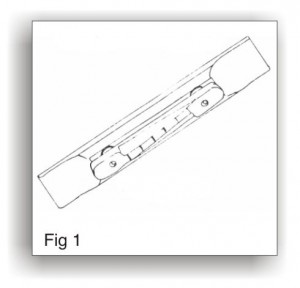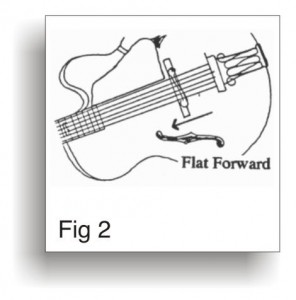FUNCTION OF INTONATION: To keep the strings in tune as they are played up the neck.
INDICATION OF PROBLEMS WITH INTONATION: Instrument won’t play in tune.
WHAT TO LOOK FOR: Since most acoustics guitars have glued on bridges with slots for the saddle, there is no easy way to adjust the intonation. If your acoustic needs to have the intonation set, talk to your local repairperson about a “compensated” saddle. Even acoustics with adjustable bridges don’t allow for front to back movement, which is what is need for setting intonation.

The following is for acoustic instruments with movable bridges that are adjustable front to back, like arch tops guitars. (Fig. # 1)
If you shorten a vibrating string exactly in half, you will raise the note of that string one (1) octave. Since the 12th fret is always the one octave point, it follows that the 12th fret must sit exactly under the string at the halfway mark . Then when you play the octave note (the 12th fret note), you have shortened the string by half. Since the frets are not movable, we must change the string length to accommodate the scale length (fret placement on the neck). The strings won’t have the same leingth, because they have different diameters.
ADJUSTMENTS: The following is how to set intonation using an electronic tuner. Later we’ll talk about this proceedure done by ear. First tune the string to standard pitch and read your electronic tuner. Next play the harmonic (or chimed note) at the 12th fret. This is done by lightly touching the string, without pushing it to the fret board, and picking it at the same time, then quickly removing your finger. If your finger is not positioned at the proper place on the string, it will not “chime”. Try moving your finger back and forth a bit around the 12th fret, until you get the chiming sound. Once you have found the chimed note at the 12th fret, that note will be exactly one octave higher than the open note.
I like to read the electronic tuner with this chimed note because it better represents the frequency of the note played at the 12th fret. Now that you’ve seen the octave note chimed on the meter, you must match this chimed note to the octave fretted note (the note played at the 12th fret). These two must read the same on the electronic tuning device.. To adjust the movable bridge in the proper direction to match notes, remember this rule of thumb-”Flat Forward” (forward being towards the headstock.)
So, if the fretted note is flat (lower in pitch than the chimed note), then you must move the bridge forward. If the fretted note is sharp (higher in pitch than the chimed note), then you need to move the bridge backwards (away from the headstock). Remember- the fretted note must always match the chimed note. The chimed note can not be wrong.
You will find that adjusting this type bridge often requires moving one side forward or back while the other side stays put. Often the bridge will actually sit crooked under the strings to allow for the needed compensation.
If you want to try and set the intonation by ear, the procedure is basically the same as mentioned above. Instead of watching the meter, you listen. When you hear the fretted note sounds the same as the chimed note, you have set your intonation properly.
CAUTIONS: One thing to remember about movable bridges is that when you take the strings off the bridge will come off also. So you don’t loose your intonation set-up, you may want to change only one string at a time, or mark the position of the bridge before changing strings.
This is the end of the acoustic guitar set up! Hope you found this helpful!!

